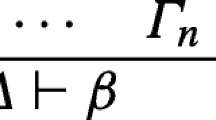Abstract
I consider two related objections to the claim that the law of excluded middle does not imply bivalence. One objection claims that the truth predicate captured by supervaluation semantics is not properly motivated. The second objection says that even if it is, LEM still implies bivalence. I show that LEM does not imply bivalence in a supervaluational language. I also argue that considering supertruth as truth can be reasonably motivated.
Similar content being viewed by others
References
McGee V.: 1989 ‘Applying Kripke's Theory of Truth’, Journal of Philosophy 86, 530–539.
Sayward C.: 1989, ‘Does the Law of Excluded Middle Require Bivalence?’, Erkenntnis 31, 129–137.
van Fraassen B. C.: 1966, ‘Singular Terms, Truth-Value Gaps, and Free Logic’, Journal of Philosophy 63, 481–495.
van Fraassen B. C.: 1971, Formal Semantics and Logic, Macmillan, New York.
Author information
Authors and Affiliations
Rights and permissions
About this article
Cite this article
Day, T.J. Excluded middle and bivalence. Erkenntnis 37, 93–97 (1992). https://doi.org/10.1007/BF00220634
Received:
Issue Date:
DOI: https://doi.org/10.1007/BF00220634



